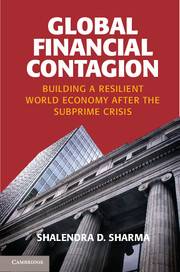Book contents
- Frontmatter
- Contents
- List of Figures
- List of Tables
- Acknowledgments
- Introduction
- One The United States
- Two The Bush and Obama Administrations’ Response
- Three From the U.S. to the European Crisis
- Four The Eurozone’s Sovereign-Debt Crisis
- Five Russia
- Six China
- Seven Japan, South Korea, and India
- Eight The Middle East amid the Global Financial Crisis
- Nine The Great Recession and the World’s Poorest
- Ten G-20 World
- Bibliography
- Index
Seven - Japan, South Korea, and India
Impact and Recovery
Published online by Cambridge University Press: 05 June 2014
- Frontmatter
- Contents
- List of Figures
- List of Tables
- Acknowledgments
- Introduction
- One The United States
- Two The Bush and Obama Administrations’ Response
- Three From the U.S. to the European Crisis
- Four The Eurozone’s Sovereign-Debt Crisis
- Five Russia
- Six China
- Seven Japan, South Korea, and India
- Eight The Middle East amid the Global Financial Crisis
- Nine The Great Recession and the World’s Poorest
- Ten G-20 World
- Bibliography
- Index
Summary
When the financial crisis erupted in the United States with the collapse of Lehman Brothers, it was widely believed that the fallout would be largely limited to the United States and that authorities there would eventually contain the crisis. After all, Asia was not the epicenter of the crisis, and the roots of the crisis were related to factors specific to the U.S. economy, especially problems associated with expansionary monetary policy that had kept U.S. interest rates low for some years and led to a real-estate bubble, rather than to systemic external factors such as an oil shock or adverse trade relations. As noted in the previous chapter, this view was prevalent not only in China, but also in Asia’s other major economies: Japan, South Korea (hereafter Korea), and India. In fact, one of Japan’s senior ministers dismissively stated that the crisis “would have no more effect than a bee sting” (Kojima 2009, 16).
This optimism was not based on wishful thinking. Since Japan, Korea, and India, like China, had little exposure to the so-called toxic subprime securities and loans originating in the United States, they were assumed to be relatively immune because the spillover effects into their economies would be minimal. In addition, Japan, the world’s second largest economy, with its substantial foreign-exchange reserves, was deemed to not only have the wherewithal to withstand the crisis, but also to serve as a source of much-needed global liquidity in an increasingly capital-scarce world. Finally, blessed with healthy corporate and banking-sector balance sheets (especially low volume of nonperforming loans, Table 7.1) and widely seen as increasingly decoupled from Western economies (that is, economic growth in Asia was becoming more independent of the United States and Western Europe), Asian economies, it was concluded, were not as vulnerable to an economic slowdown emanating from the United States and Europe. Indeed, conventional thinking assumed that Asia’s resilient economies could serve as both “shock absorbers” and as the world’s “locomotive” – and thereby help to pull the U.S. and the global economy out of its malaise.
- Type
- Chapter
- Information
- Global Financial ContagionBuilding a Resilient World Economy after the Subprime Crisis, pp. 234 - 260Publisher: Cambridge University PressPrint publication year: 2013



